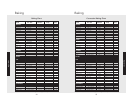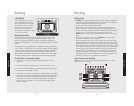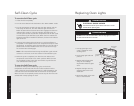
39
38
Product Care
Control Knobs
MAKE SURE ALL THE CONTROL KNOBS POINT TO THE OFF
POSITION BEFORE REMOVING. Pull the knobs straight off. Wash in
detergent and warm water. Dry completely and replace by pushing firmly
onto stem.
Stainless Steel Parts
All stainless steel body parts should be wiped regularly with hot soapy
water at the end of each cooling period and with a liquid cleaner
designed for that material when soapy water will not do the job.
DO NOT use steel wool, abrasive cloths, cleansers, or powders. If
necessary, scrape stainless steel to remove encrusted materials, soak the
area with hot towels to loosen the material, then use a wooden or nylon
spatula or scraper. DO NOT use a metal knife, spatula, or any other
metal tool to scrape stainless steel. DO NOT permit citrus or tomato
juice to remain on stainless steel surface, as citric acid will permanently
discolor stainless steel. Wipe up any spills immediately.
Oven Racks
Clean with detergent and hot water. Stubborn spots can be scoured
with a soap-filled steel wool pad. DO NOT CLEAN THE OVEN RACKS
OR RACK SUPPORT USING THE SELF-CLEAN CYCLE. They could
sustain damage due to the extreme heat of the Self-Clean cycle.
Cleaning and Maintenance
Product Care
Power Failure
If power failure occurs, the electric igniters will not work. No attempt
should be made to operate the appliance during a power failure. Make
sure the oven control is in the “OFF” position. Momentary power failure
can occur unnoticed. The range is affected only when the power is
interrupted. When it comes back on, the range will function properly
without any adjustments. A “brown-out” may or may not affect range
operation, depending on how severe the power loss is. If the range is in
the self-clean cycle when the power failure occurs, wait until power is
restored and allow door to unlock automatically. Turn all controls off and
restart self-clean cycle again, according to instructions.
WARNING
POWER FAILURE WARNING
Due to safety considerations and the possibility of personal injury in
attempting to light and extinguish the burner, the grill should, not under
any circumstances, be used during a power failure. The grill burner
control should always remain in the “OFF” position during a power failure.
This oven features an automatic pyrolytic self-cleaning cycle. During
this cycle, the oven reaches elevated temperatures in order to burn-off
soil and deposits. An integral smoke eliminator helps reduce odors
associated with the soil burn-off. A powder ash residue is left in the
bottom of the oven after completion of the self-clean cycle. The door
latch is automatically activated after selecting the self-clean setting.
The latch ensures that the door cannot be opened while the oven
interior is at clean temperatures.
Before starting the Self-Clean cycle:
1. Remove the oven racks, and any other items/utensils from the oven.
The high heat generated during the cleaning cycle can discolor,
warp, and damage these items. DO NOT use foil or liners in the
oven. During the self-clean cycle, foil can burn or melt and damage
the oven surface.
2. Wipe off any large spills from the oven bottom and sides. NEVER
use oven cleaners inside a self-cleaning oven or on raised portions
of the door.
3. Some areas of the oven must be cleaned by hand before the cycle
begins. Soils in these areas will be baked on and very difficult to
clean if not removed first. Clean the door up to the gasket, the
door frame, and up to 2 inches inside the frame with detergent and
hot water. Rinse thoroughly and dry.
CAUTION
WARNING
BURN OR ELECTRICAL SHOCK HAZARD
Make sure all controls are OFF and oven is COOL before cleaning.
Failure to do so can result in burns or electrical shock.
DO NOT touch the exterior portions of the oven after self-cleaning
cycle has begun, since some parts become extremely hot to the touch!
During the first few times the self-cleaning feature is used, there may
be some odor and smoking from the “curing” of the binder in the high-
density insulation used in the oven. When the insulation is thoroughly
cured, this odor will disappear. During subsequent self-cleaning
cycles, you may sense an odor characteristic of high temperatures.
KEEP THE KITCHEN WELL-VENTED DURING THE
SELF-CLEAN CYCLE.
Self-Clean Cycle


















